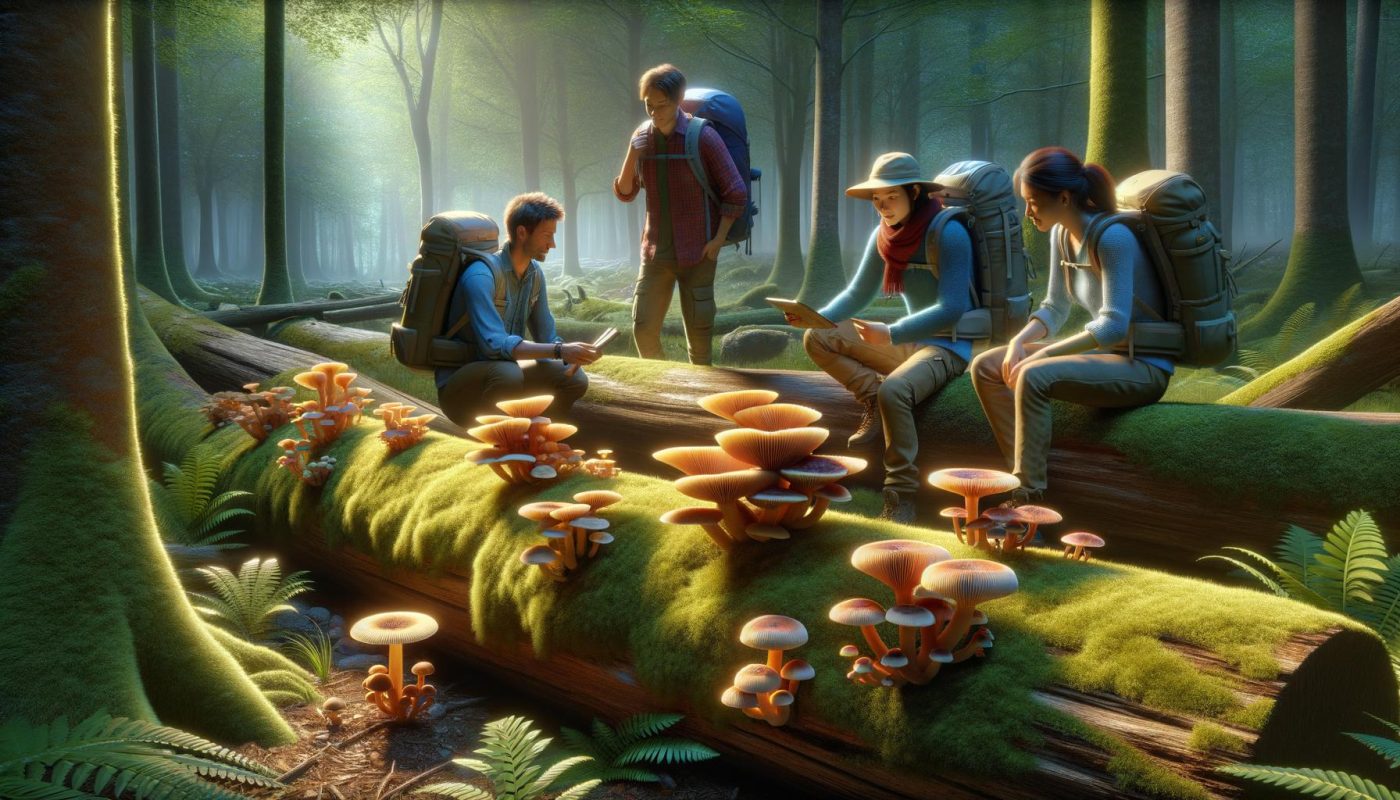Uncategorized
How to Distinguish Regular from Psychedelic Mushrooms
At Newphoria, we’re often asked about the difference between regular mushrooms and psychedelic mushrooms. This topic requires careful consideration due to its legal and safety implications.
In this post, we’ll explore the key physical characteristics that set psychedelic mushrooms apart from their non-psychoactive counterparts. We’ll also discuss the importance of proper identification and the potential risks involved.
What Makes Psychedelic Mushrooms Unique?
Psychedelic mushrooms, often called “magic mushrooms,” possess distinct physical traits that differentiate them from regular mushrooms. These characteristics play a key role in identification, but visual identification alone is not foolproof and can pose significant dangers.
The Blue Bruising Phenomenon
Many psychedelic mushrooms exhibit a tendency to bruise blue when handled or damaged. This reaction occurs due to the oxidation of psilocin, a compound present in these mushrooms. However, it’s important to note that not all blue-bruising mushrooms are psychoactive, and not all psychoactive mushrooms bruise blue.
Distinctive Shapes and Sizes
Psychedelic mushrooms often feature slender stems and cone-shaped caps, though this can vary among species. For example, the popular Psilocybe cubensis typically has a golden-brown cap that appears convex when young and flattens with age. Its stem usually presents as thick and white.
Color Variations Across Species
The color of psychedelic mushrooms can range significantly. Some species, like Psilocybe azurescens, display caramel-colored caps, while others, such as Psilocybe cyanescens, are known for their wavy caps that appear chestnut brown when moist and fade to pale buff (or nearly white) when dry.
Habitat and Growing Conditions
Psychedelic mushrooms often thrive in specific environments. Many species prefer damp, shaded areas with rich organic matter. For instance, Psilocybe cubensis often grows on cow dung in tropical and subtropical climates, while Psilocybe cyanescens favors coniferous woodlands of the north-western United States or coastal dunes in the PNW.
Spore Print Characteristics
The spore print (the pattern left by spores when a mushroom cap is placed on paper) can provide valuable information for identification. Many psychedelic mushrooms produce dark purple-brown to black spore prints, which can help distinguish them from non-psychoactive species with different spore colors.
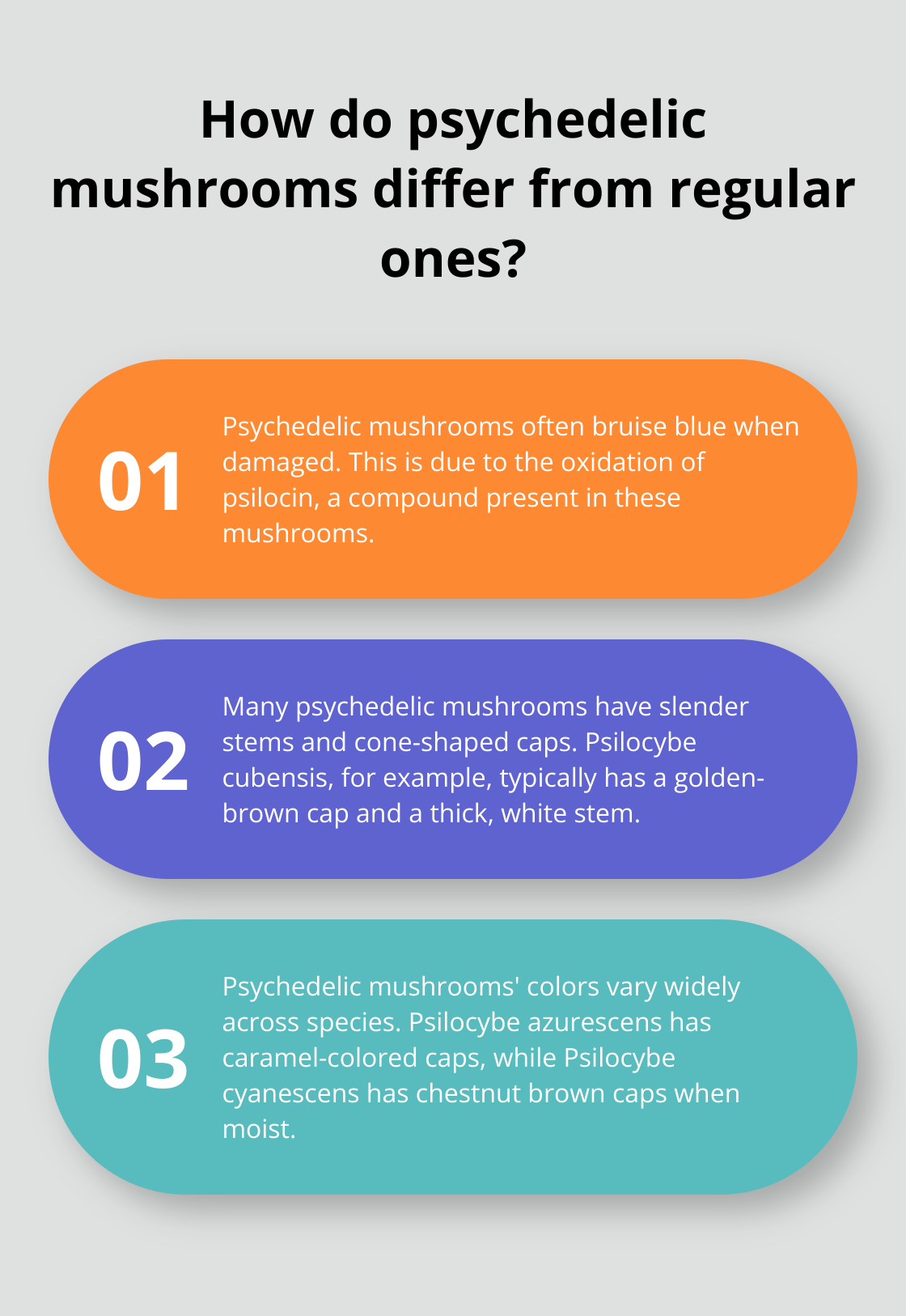
These physical characteristics alone do not suffice for safe identification of psychedelic mushrooms. Many poisonous mushrooms share similar traits, and misidentification can lead to severe health risks. Expert consultation or the use of reliable identification guides is essential before considering any wild mushroom for consumption.
The next chapter will explore the key differences between psychedelic and regular mushrooms, providing further insights into their distinct features and chemical compositions.
What Sets Psychedelic Mushrooms Apart?
Psychedelic mushrooms differ from regular mushrooms in several key aspects. Understanding these differences is essential for anyone interested in mycology or the study of fungi.
Spore Print Characteristics
The spore prints of psychedelic mushrooms provide a reliable method to distinguish them from regular ones. Psilocybe cubensis, commonly known as the magic mushroom, shroom, golden halo, golden teacher, cube, or gold cap, typically produces dark purple-brown to black spore prints. For example, Psilocybe cubensis has a dark purple-brown spore print, while many edible mushrooms (like button mushrooms, Agaricus bisporus) have a chocolate brown spore print.
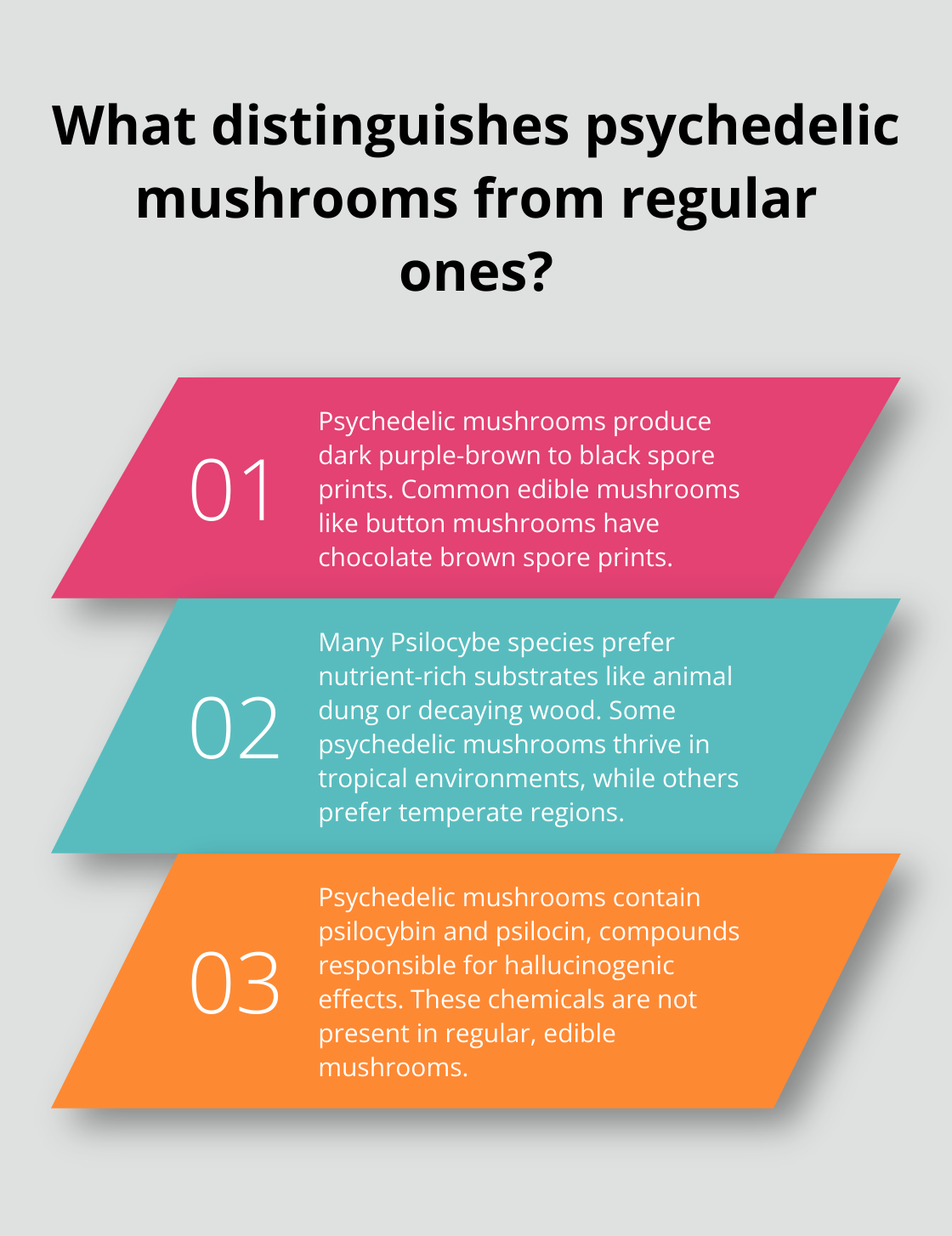
To create a spore print, place the cap of a mature mushroom, gills down, on a piece of white paper. Cover it with a glass and leave it for several hours. The resulting pattern and color can help with identification. However, spore print color alone does not suffice for definitive identification.
Unique Growing Environments
Psychedelic mushrooms often thrive in specific habitats that differ from those of common edible mushrooms. Many Psilocybe species prefer nutrient-rich substrates like animal dung or decaying wood. For instance, Psilocybe semilanceata (commonly known as Liberty Caps) often grows in grassy areas, particularly in sheep pastures. In contrast, many culinary mushrooms like shiitake or oyster mushrooms grow on logs or sawdust.
Climate also influences growth. While some psychedelic mushrooms (like Psilocybe cubensis) prefer tropical and subtropical environments, others (such as Psilocybe cyanescens) thrive in temperate regions. This contrasts with many common edible mushrooms that can grow in a wide range of climates.
Chemical Composition
The most significant difference between psychedelic and regular mushrooms lies in their chemical makeup. Psychedelic mushrooms contain psilocybin and psilocin, compounds responsible for their hallucinogenic effects. These chemicals do not exist in regular, edible mushrooms.
The presence of these compounds makes psychedelic mushrooms illegal in many countries. It’s important to understand and comply with local laws and regulations regarding psychedelic substances.
Physical Characteristics
Psychedelic mushrooms often have distinct physical features. Many species exhibit blue bruising when handled or damaged, a reaction caused by the oxidation of psilocin. However, not all blue-bruising mushrooms contain psilocybin, and not all psilocybin-containing mushrooms bruise blue.
The shape and size of psychedelic mushrooms can also differ from common edible varieties. Many psilocybin-containing species have slender stems and cone-shaped caps, although this varies among species. Color can range from golden-brown to caramel or chestnut brown, depending on the specific type and genetic makeup.
While these differences can help distinguish psychedelic mushrooms from regular ones, visual identification alone never suffices. Misidentification can lead to severe health risks or legal issues (or both). Expert consultation or reliable scientific methods should always be used for accurate identification. The next section will explore the legal and safety considerations surrounding psychedelic mushrooms, providing crucial information for those interested in this topic.
Legal Risks and Safety Precautions
The Complexity of Mushroom Identification
Identifying psychedelic mushrooms presents significant challenges and carries substantial legal and health risks. In Canada, psilocybin and psilocin (the active compounds in magic mushrooms) fall under Schedule III controlled substances in the Controlled Drugs and Substances Act. This classification prohibits possession, sale, or distribution without proper authorization.
Consequences of Misidentification
Mushroom misidentification can lead to severe outcomes. A study published in Research Gate reported a total of 367,974 cases of poisonings and poison exposures observed during 2010-2020. Many toxic mushrooms bear a close resemblance to psychedelic species, which renders visual identification unreliable and potentially life-threatening.
Legal Implications of Possession
Penalties for possessing psychedelic mushrooms vary across jurisdictions. In Canada, the Controlled Drugs and Substances Act defines offence-related property as any property, within or outside Canada, by means of or in respect of which a designated substance offence is committed.
Exploring Legal Alternatives
Those interested in psychedelic experiences have access to legal and safer alternatives. Some companies offer products that provide similar experiences without the legal risks associated with psilocybin mushrooms. These alternatives (such as MDMA Moon Edibles and LSD microdoses) offer controlled and measured experiences that eliminate the need for potentially dangerous foraging.
The Value of Expert Consultation
For those determined to identify wild mushrooms, consulting a professional mycologist remains essential. The North American Mycological Association maintains a directory of local mushroom clubs and experts who provide reliable identification services. Absolute certainty of a mushroom’s identity and safety must precede any consumption.
Safety Considerations
Psilocybin use comes with potential risks, including the possibility of experiencing adverse psychological effects such as anxiety or distress during the experience. It’s crucial to approach any psychedelic use with caution and proper preparation.
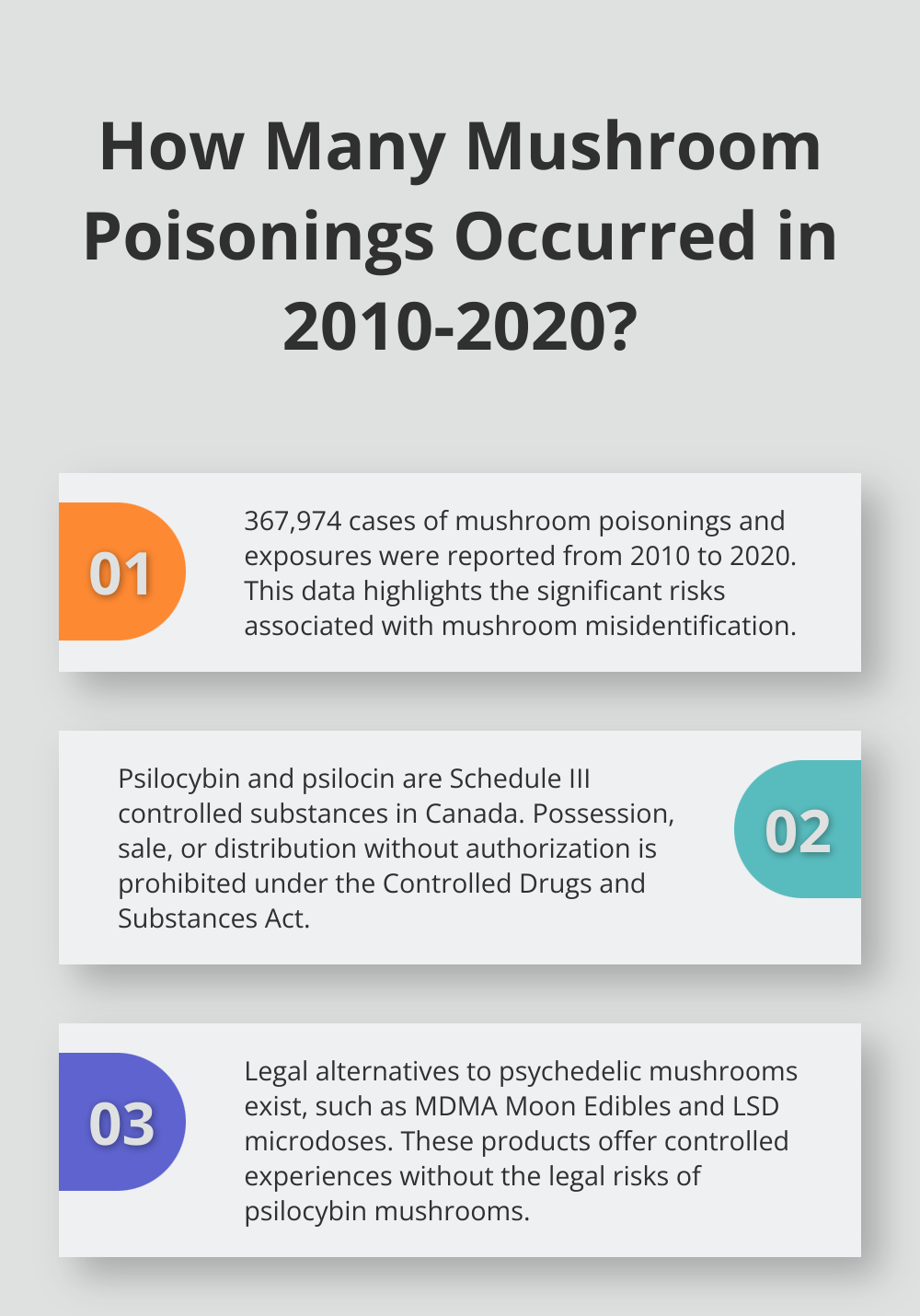
Final Thoughts
The difference between regular mushrooms and psychedelic mushrooms requires expert knowledge and careful observation. Physical characteristics, spore print color, and growing conditions provide initial clues, but these features alone do not suffice for accurate identification. Visual identification can lead to severe legal issues or health problems, as many countries classify psychedelic mushrooms as controlled substances.
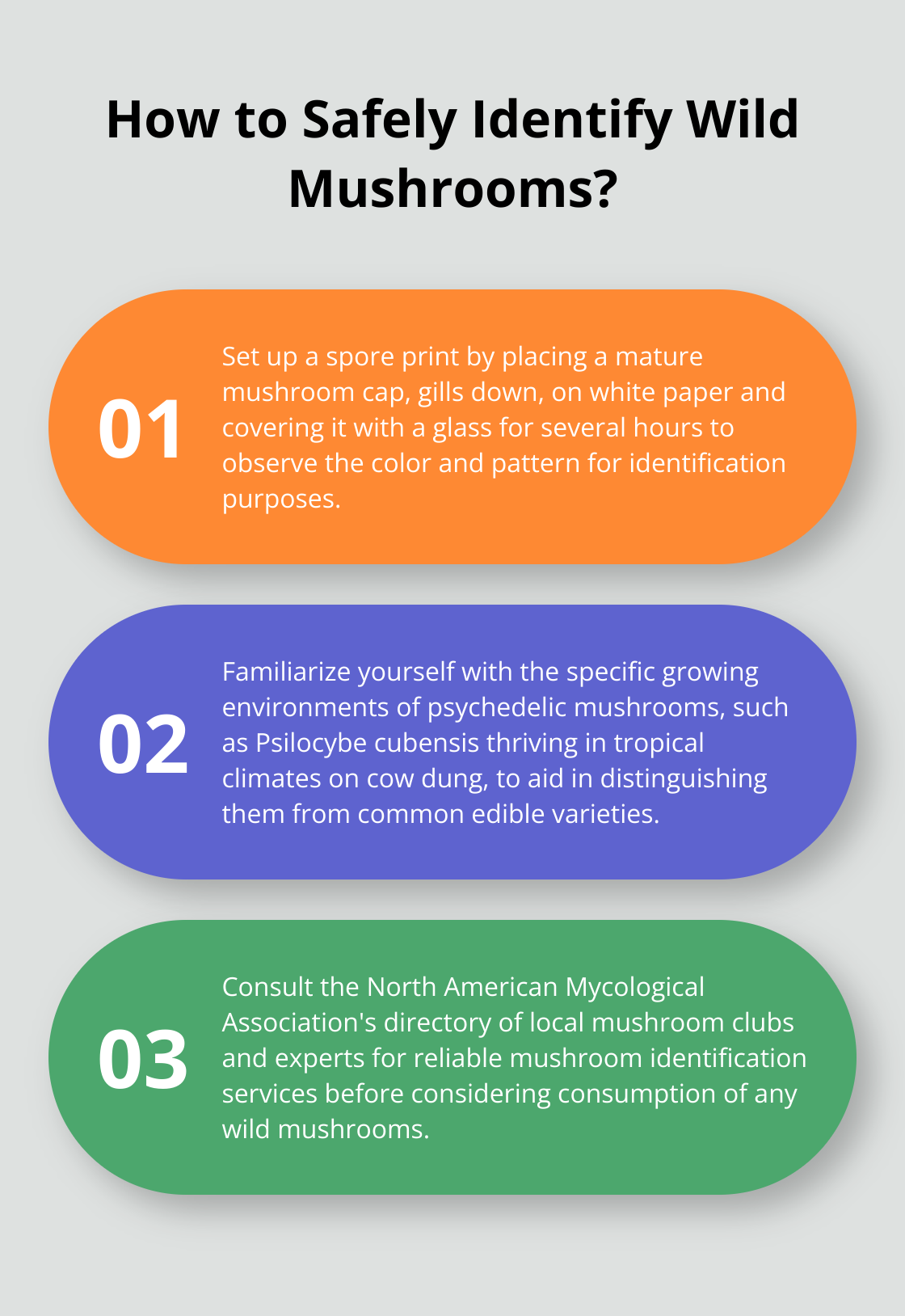
We at Newphoria strongly advise against attempting to identify psychedelic mushrooms without expert consultation. Mycologists and local mushroom clubs offer valuable insights and guidance for safe and legal mushroom identification. The risks of misidentification outweigh any potential benefits, making professional assistance essential.
For those who want to explore psychedelic experiences safely and legally, Newphoria offers alternatives such as MDMA Moon Edibles and LSD microdoses. These products provide controlled experiences without the risks associated with wild mushroom foraging. Responsible behavior and respect for the law remain paramount when approaching the topic of psychedelics (and their potential therapeutic uses).

